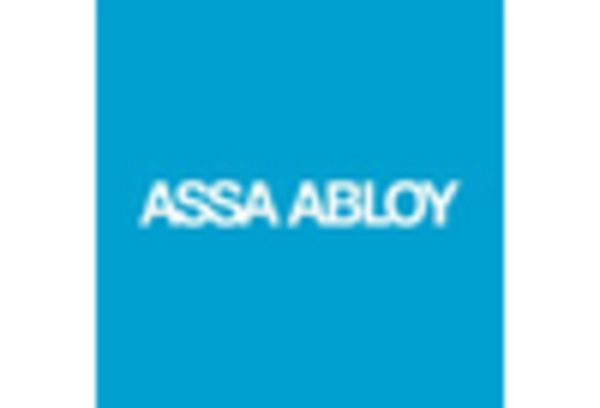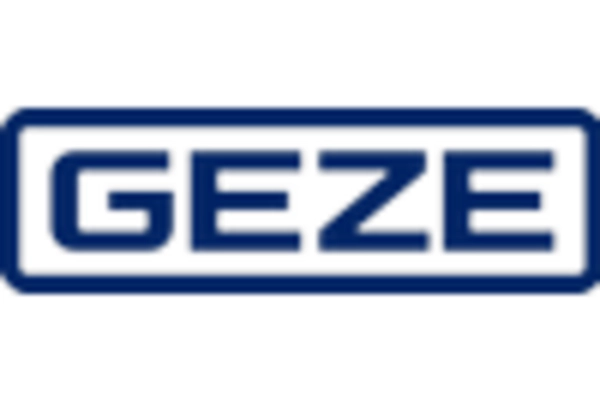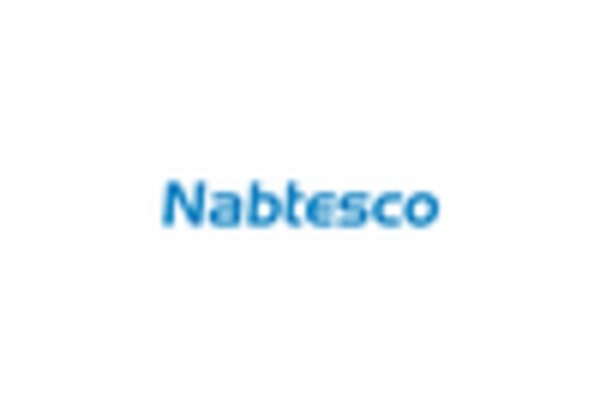Rising Demand for Energy Efficiency
The Automatic Sliding Door Market experiences a notable surge in demand for energy-efficient solutions. As energy costs continue to rise, businesses and consumers alike are increasingly seeking ways to reduce their energy consumption. Automatic sliding doors, designed with advanced insulation and sensor technologies, contribute to energy savings by minimizing air leakage and maintaining indoor climate control. According to recent data, energy-efficient doors can reduce heating and cooling costs by up to 30%. This trend is particularly evident in commercial sectors such as retail and hospitality, where energy efficiency not only lowers operational costs but also enhances the overall customer experience. Consequently, manufacturers are focusing on developing automatic sliding doors that meet stringent energy standards, thereby driving growth in the Automatic Sliding Door Market.
Growing Awareness of Aesthetic Value
The aesthetic appeal of automatic sliding doors is becoming a significant driver in the Automatic Sliding Door Market. As businesses strive to create inviting and visually appealing environments, the design of entryways plays a crucial role. Automatic sliding doors are available in various styles, materials, and finishes, allowing for customization that aligns with the overall architectural vision. This trend is particularly prominent in sectors such as hospitality and retail, where first impressions are vital. Market analysis indicates that consumers are increasingly willing to invest in high-quality, aesthetically pleasing doors that enhance the overall ambiance of their establishments. Consequently, manufacturers are focusing on innovative designs and customizable options, which not only meet functional requirements but also cater to the growing demand for aesthetic value in the Automatic Sliding Door Market.
Increased Focus on Safety and Security
Safety and security concerns are paramount in the Automatic Sliding Door Market, particularly in high-traffic areas such as airports, hospitals, and shopping centers. The integration of advanced safety features, such as motion sensors and emergency stop mechanisms, is becoming increasingly common. These features not only prevent accidents but also enhance the overall security of the premises. Recent statistics indicate that incidents related to door malfunctions can lead to significant liability issues for businesses. As a result, there is a growing emphasis on compliance with safety regulations and standards, which drives innovation in the design and functionality of automatic sliding doors. This focus on safety and security is likely to propel the demand for automatic sliding doors, as businesses prioritize the well-being of their customers and employees.
Technological Advancements in Automation
Technological advancements play a crucial role in shaping the Automatic Sliding Door Market. Innovations in automation technology, such as the integration of IoT and smart sensors, are enhancing the functionality and efficiency of automatic sliding doors. These advancements allow for features like remote access control, real-time monitoring, and predictive maintenance, which improve user experience and operational efficiency. The market is witnessing a shift towards more sophisticated systems that can adapt to user behavior and environmental conditions. As businesses increasingly adopt smart building technologies, the demand for advanced automatic sliding doors is expected to rise. This trend not only enhances convenience but also aligns with the growing emphasis on automation in various sectors, thereby driving growth in the Automatic Sliding Door Market.
Expansion of Retail and Commercial Spaces
The Automatic Sliding Door Market is significantly influenced by the expansion of retail and commercial spaces. As urbanization continues to rise, new shopping malls, office buildings, and commercial complexes are being developed, creating a robust demand for automatic sliding doors. These doors are favored for their convenience and aesthetic appeal, allowing for seamless entry and exit in busy environments. Market data suggests that the retail sector alone accounts for a substantial portion of automatic sliding door installations, with projections indicating a steady growth rate in this segment. Furthermore, the trend towards open-concept designs in commercial architecture further fuels the need for automatic sliding doors, as they facilitate smooth transitions between spaces while enhancing the overall ambiance of the environment.


















Leave a Comment